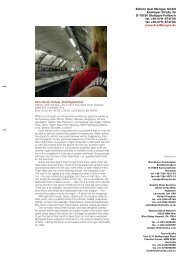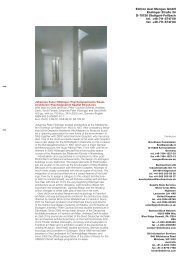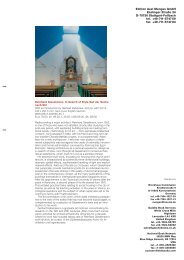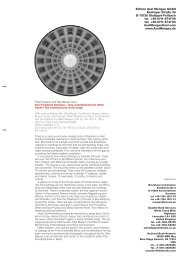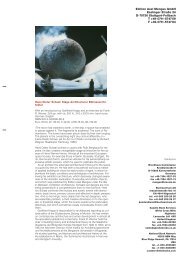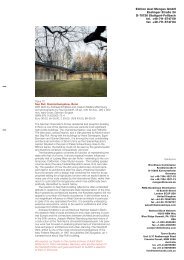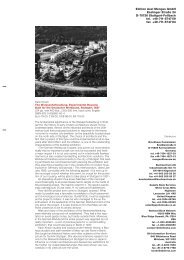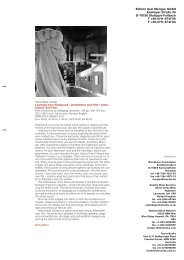The Architecture of East Australia - Edition Axel Menges
The Architecture of East Australia - Edition Axel Menges
The Architecture of East Australia - Edition Axel Menges
Create successful ePaper yourself
Turn your PDF publications into a flip-book with our unique Google optimized e-Paper software.
In 1840 Sir Thomas Mitchell, Surveyor General <strong>of</strong> the British Crown,<br />
chose a rocky promontory on Sydney harbour for his home. He built<br />
a cottage in the style <strong>of</strong> the Gothic Revival, popularized in England<br />
by Augustus Welby Northmore Pugin and documented in popular<br />
copy books shipped with his baggage from his home country. <strong>The</strong><br />
house perfectly expresses the imaginative dislocation <strong>of</strong> European<br />
culture into the romantic wilderness. Whether they came out <strong>of</strong> duty,<br />
like Mitchell, or in the hope <strong>of</strong> opportunity, the European immigrants<br />
viewed <strong>Australia</strong> as a »terra nullius«, as an empty land, a vacant<br />
space waiting to receive a model <strong>of</strong> Christian civilization.<br />
It took a century to realize that the dream did not comfortably fit<br />
the continent. <strong>The</strong> story <strong>of</strong> <strong>Australia</strong>n architecture might be said to<br />
parallel the endeavours <strong>of</strong> <strong>Australia</strong>ns to adapt and reconcile themselves<br />
with their home and neighbours. It is the story <strong>of</strong> 200 years <strong>of</strong><br />
coming to terms with the land: <strong>of</strong> adaptation, insight and making do.<br />
Early settlers were poorly provisioned, pr<strong>of</strong>oundly ignorant <strong>of</strong> the land<br />
and richly prejudiced towards its peoples. <strong>The</strong>y pursued many paths<br />
over many terrains. From the moist temperate region <strong>of</strong> Tasmania<br />
with heavy Palladian villas to the monsoonal north with open, lightweight<br />
stilt houses, the continent has induced most different regional<br />
building styles.<br />
<strong>The</strong> buildings included within this guide extend from the first examples<br />
<strong>of</strong> <strong>Australia</strong>n architecture by convict architect Francis Greenway<br />
to the works by today’s rising generation. It covers not only buildings<br />
by such famous architects as Walter Burley Griffin, Harry Seidler, Jørn<br />
Utzon, John Andrews, Philip Cox, Glenn Murcutt and Alex Popov, but<br />
also many high-quality works by less known exponents <strong>of</strong> the pr<strong>of</strong>ession.<br />
Photographs by the renowned Max Dupain and the present proprietor<br />
<strong>of</strong> his firm, Eric Sierins, including many especially commissioned<br />
for this book, support the text. Contributing authors have supplied<br />
material where vital local knowledge is essential. Bill MacMahon<br />
is an architect practising in Sydney, a lecturer at the University <strong>of</strong> New<br />
South Wales and a contributor to various <strong>Australia</strong>n architectural and<br />
design journals.<br />
ISBN 3-930698-90-0<br />
9 783930 698905<br />
Bill MacMahon <strong>The</strong> <strong>Architecture</strong> <strong>of</strong> <strong>East</strong> <strong>Australia</strong> <strong>Menges</strong><br />
Bill MacMahon<br />
<strong>The</strong> <strong>Architecture</strong> <strong>of</strong> <strong>East</strong> <strong>Australia</strong>




